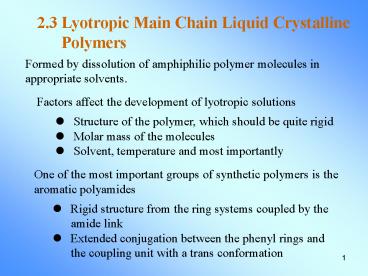Example of PDLC architectural window - PowerPoint PPT Presentation
1 / 18
Title:
Example of PDLC architectural window
Description:
Title: Example of PDLC architectural window Author: Ming Last modified by: A satisfied Microsoft Office User Created Date: 1/27/2004 6:48:37 AM Document presentation ... – PowerPoint PPT presentation
Number of Views:74
Avg rating:3.0/5.0
Title: Example of PDLC architectural window
1
2.3 Lyotropic Main Chain Liquid Crystalline
Polymers
Formed by dissolution of amphiphilic polymer
molecules in appropriate solvents.
- Factors affect the development of lyotropic
solutions - Structure of the polymer, which should be
quite rigid - Molar mass of the molecules
- Solvent, temperature and most importantly
- One of the most important groups of synthetic
polymers is the aromatic polyamides - Rigid structure from the ring systems coupled
by the - amide link
- Extended conjugation between the phenyl rings
and - the coupling unit with a trans conformation
2
Solvent Systems
For poly(L-glutamate)s dioxane, methylene
chloride For aromatic polyamides protonating
acids H2SO4, CF3SO3H, CH3SO3H strong aprotic
solvents hexamethylene phosphoramide (HMPA),
dimethylacetamide (DMAC), or N-mehtyl pyrrolidone
(NMP) with a small amount of LiCl or CaCl2
- Characteristic viscosity behavior
- Viscosity increases with the increase in polymer
concentration - Sharp decrease in the viscosity at a critical
polymer concentration because of the formation of
the oriented nematic domains.
The additional chain orientation in the direction
of the fiber long axis leads to a dramatic
enhancement of the polymer properties.
Alternatives to metal or carbon fibers.
3
(No Transcript)
4
(No Transcript)
5
2.4. Thermotropic Main Chain Liquid Crystalline
Polymers
- Many of thermotropic main chain liquid crystal
polymers are polyesters that are synthesized by
condensation reactions - Interfacial polymerization
- High temperature solution polymerization
- Ester interchange reaction in the melt
- Commonly used monomer units
- Hydroxybenzoic acid
- p-Terephthalic acid
- 2,6-Naphthalene dicarboxylic acid
- 4,4-Biphenol
6
(No Transcript)
7
(No Transcript)
8
- Polymer prepared by condensation polymerization
tends to be - Very insoluble
- High melting point
- Mesomorphic transitions at high temperatures
- Difficult to process
- The melting points of the main chain liquid
crystal polymers can be reduced in a number of
different ways - Incorporation of flexible spacer units
- Copolymerization of several mesogenic monomers
of - different sizes to give a random and more
irregular structure - Introduction of lateral substituents to disrupt
the chain - symmetry
- Synthesis of chains with kinks, such as
unsymmetrically - linked aromatic units
9
(No Transcript)
10
The use of flexible spacers is a popular approach
- Flexible units of varying length space the
mesogens along the chain and reduce the overall
rigidity. - The bridging groups in the repeat units must be
rigid to maintain the overall stiffness of
mesogens, and they are unusually multiple bond
units. - Ester groups also serve this purpose,
particularly when in conjunction with aryl rings
where the conjugation leads to stiffening of the
overall structure. - Small variation in structure can lead to
formation of different mesophase. - When the number of methylene unit (n) in the
spacer is - odd, a nematic phase is observed.
- When n is even, a smectic mesophase results.
11
(No Transcript)
12
For polyesters with multiple rings but different
orientation of the ester units, the phase can
also be changed. The introduction of a flexible
spacer can lower the melting point and increase
the temperature rang in which the mesophase is
stable. Both Tm (melting point) and Ti
(isotropization temperature) decrease as n
increases. The polymers with spacers having an
even number of CH2 units usually have higher Tm
and Ti than those with an odd number. The long
rang ordering will tend to try and maintain the
orientation of mesogen parallel to the director
axis and this may be easier for even numbered CH2
unit spacers if they are in the all trans zig-zag
conformation.
13
Modification of poly(ethylene terephthalate) by
reacting the preformed polymer with
p-acetoxybenzoic acid.
14
Introducing a mesogenic unit to the structure at
the points where the two units combine, producing
a thermotropic liquid crystal polymer with a
flexible spacer. At 30 mol incorporation, a
nematic phase appears in the melt. The optimum
mechanical properties are obtained when 60 to 70
of the oxybenzoate is present in the chain (a
large increase in the tensile strength
accompanied by a corresponding decrease in the
melt viscosity). Introduction of a lateral
substituent into the mesogen will also lower Tm
and Ti, as the bulky side groups will tend to
force the chains apart thereby reducing the
intermolecular forces of attraction.
15
(No Transcript)
16
(No Transcript)
17
The introduction of kinks by using meta
substituted monomer or a crankshaft monomer such
as 6-hydroxy-2-naphthoic acid (HNA) can be
equally effective. Other strategies for
disrupting chain symmetry include the use of
cross-shaped molecules or discotic
mesogens. Plasticization of polyester with a
small liquid crystal molecule to lower the
processing temperature. Bridging groups other
than esters are also used.
18
(No Transcript)































